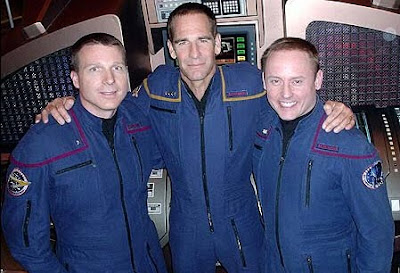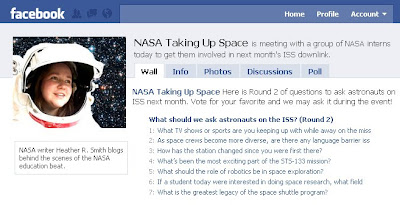
Subtitle of this post should be
The Scientist II... continuing from the last post about Ronita Cromwell, head scientist of the
Flight Analog Program (
FAP) for the past 3 years.
She prepared a
marvelous slideshow about all the various analog programs that support NASA investigations, such as NEEMO (NASA Extreme Environment Mission operations), Haughton-Mars simulations, isolation experiments in Antartica, and medical simulation studies.
Some of my blogger-buds, such as Amnon Govrin at
Spacepirations, Brian Shiro at
Astronaut for Hire and Laksen Sirimanne at
The Sky Is Not The Limit have participated in these programs... definitely check out their great blogs for details. I have yet to nail an interview with someone who has been in the underwater NEEMO habitat. Searching!

The latter portion of the
slideshow will be of interest to folks considering their application for the new
iRATS medical studies at NASA. She included details about screening, the specialized diet...and slide #16 shows "my" old room at UTMB on Galveston Island, LOL! But perhaps it could be yours soon...
Dr. Cromwell also spent 25 years in academia as a faculty member at a number of universities. Her research was in the area of visual and vestibular control of dynamic balance. She began by focusing on physiological mechanisms for dynamic balance and then applied this to fall prevention in older adults.
While I, of course, have always been most interested in her work for NASA in the area of human analogs, her incredible history of publications over the past decade is impressive... and some of them truly drive home the message that “analog” studies for space flight can also be incredibly beneficial to medical conditions we face on Earth:
Cromwell, RL, Newton, RA, Carlton, LG:
Horizontal plane head stabilization during locomotor tasks. Journal of Motor Behavior, 33:49-58, 2001.
Cromwell, RL, Wellmon, R:
Sagittal plane head stabilization during level walking and ambulation on stairs. Physiotherapy Research International. 6:179-192, 2001.
Cromwell, RL, Newton, RA, Forrest, G:
Head stability in older adults during walking with and without visual input. Journal of Vestibular Research, 11,105-114, 2001.
Cromwell, RL, Newton, RA, Forrest, G:
Influence of vision on head stabilization strategies in older adults during walking. Journal of Gerontology: Medical Sciences, 57A: M442-M448, 2002.
Cromwell, RL:
Movement strategies for head stabilization during incline walking. Gait & Posture, 17: 246-253, 2003.
Cromwell, RL & Newton, RA:
Relationship between balance and gait stability in healthy older adults. Journal of Aging and Physical Activity, 12:90-100, 2004.
Cromwell, RL, Schurter, JB, Shelton, S, Vora, S.
Head stabilization strategies in the sagittal plane during locomotor tasks. Physiotherapy Research International, 9:33-42, 2004.
Cromwell, RL, Pidcoe, PE, Griffin, LA, Sotillo, T, Ganninger, D, Feagin, M:
Adaptations in horizontal head stabilization in response to altered vision and gaze during natural walking. Journal of Vestibuar Research, 14: 367-373, 2004.
Rogers, HL, Cromwell, RL, Newton, RA:
Association of balance measures and perception of fall risk on gait speed: a multiple regression analysis. Experimental Aging Research, 31:191-203, 2005.
Cromwell, RL, Meyers, PM, Meyers, PE, Newton, RA:
Tae Kwon Do: An effective exercise for improving balance and walking ability in older adults. Journal of Gerontology: Medical Sciences, 62A (6): 641-646, 2007.
Rogers, HL, Cromwell, RL:
Adaptive changes in gait in older and younger adults as responses to proprioceptive and visual challenges to dynamic balance. Journal of Aging and Physical Activity, 6(1): 85-96, 2008.
De Witt, JK, Cromwell, RL, Hagan, RD:
The effect of increasing Inertia upon Vertical Ground Reaction Forces during Locomotion. Journal of Experimental Biology, 211: 1087-1092, 2008.
Buccello-Stout, R.R, Bloomberg, JJ, Cohen, HS, Whorton, EB, Weaver, GD, Cromwell, RL:
Effects of sensorimotor adaptation training on functional mobility in older adults. Journals of Gerontology Series B: Psychological Sciences. 63(5):P295-300, 2008.
Newton, RA, Cromwell, RL, Rogers, HL:
The relationship between physical performance and obesity in elderly African American women. Physical & Occupational Therapy in Geriatrics, 27(6):423-440, 2009.
What a list! Kinda makes me wonder what I've been doing with my time...

























